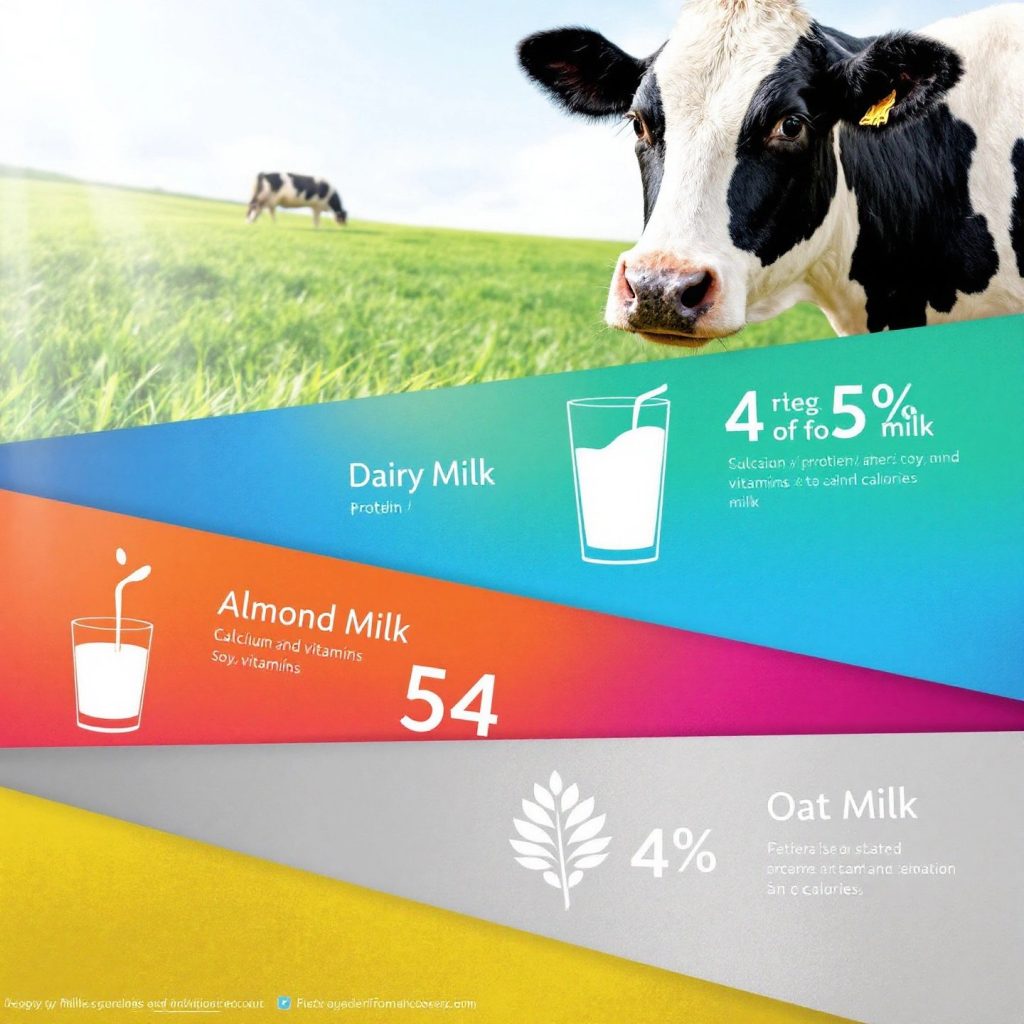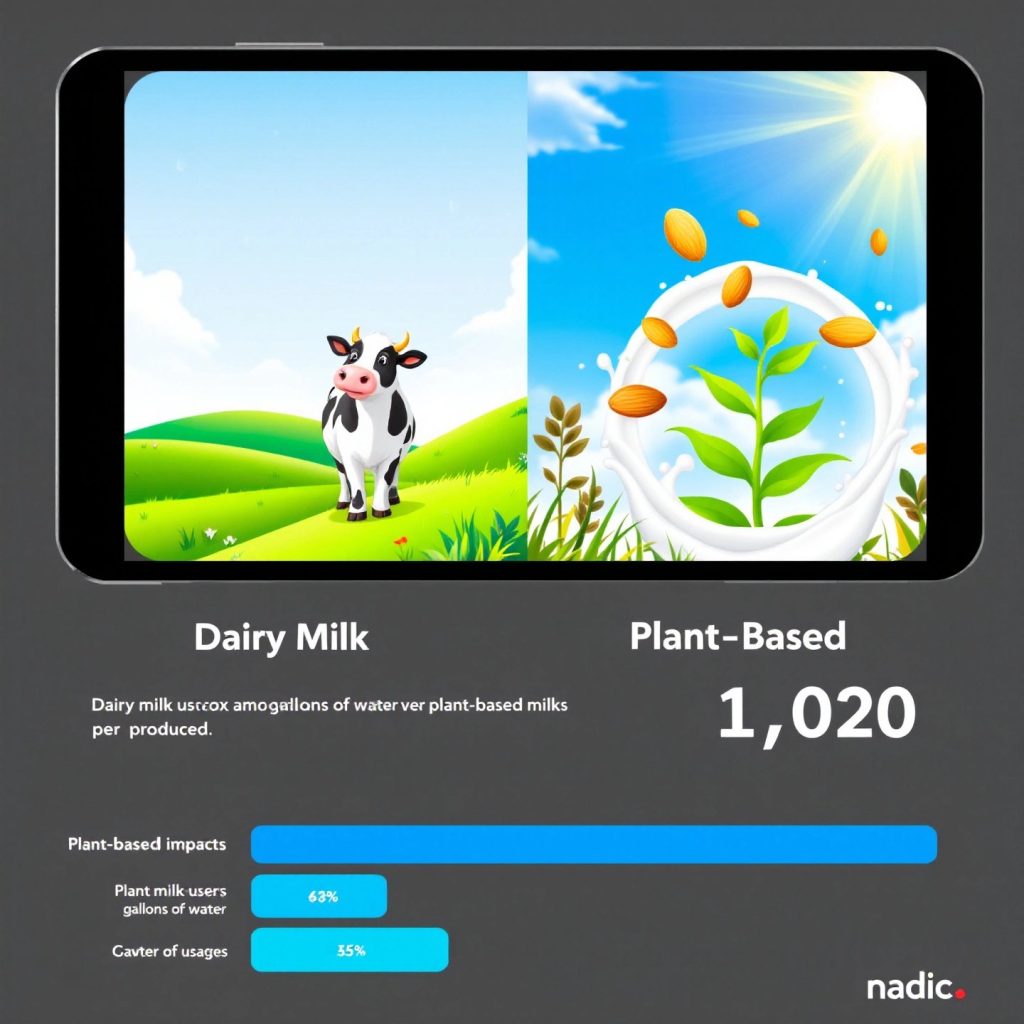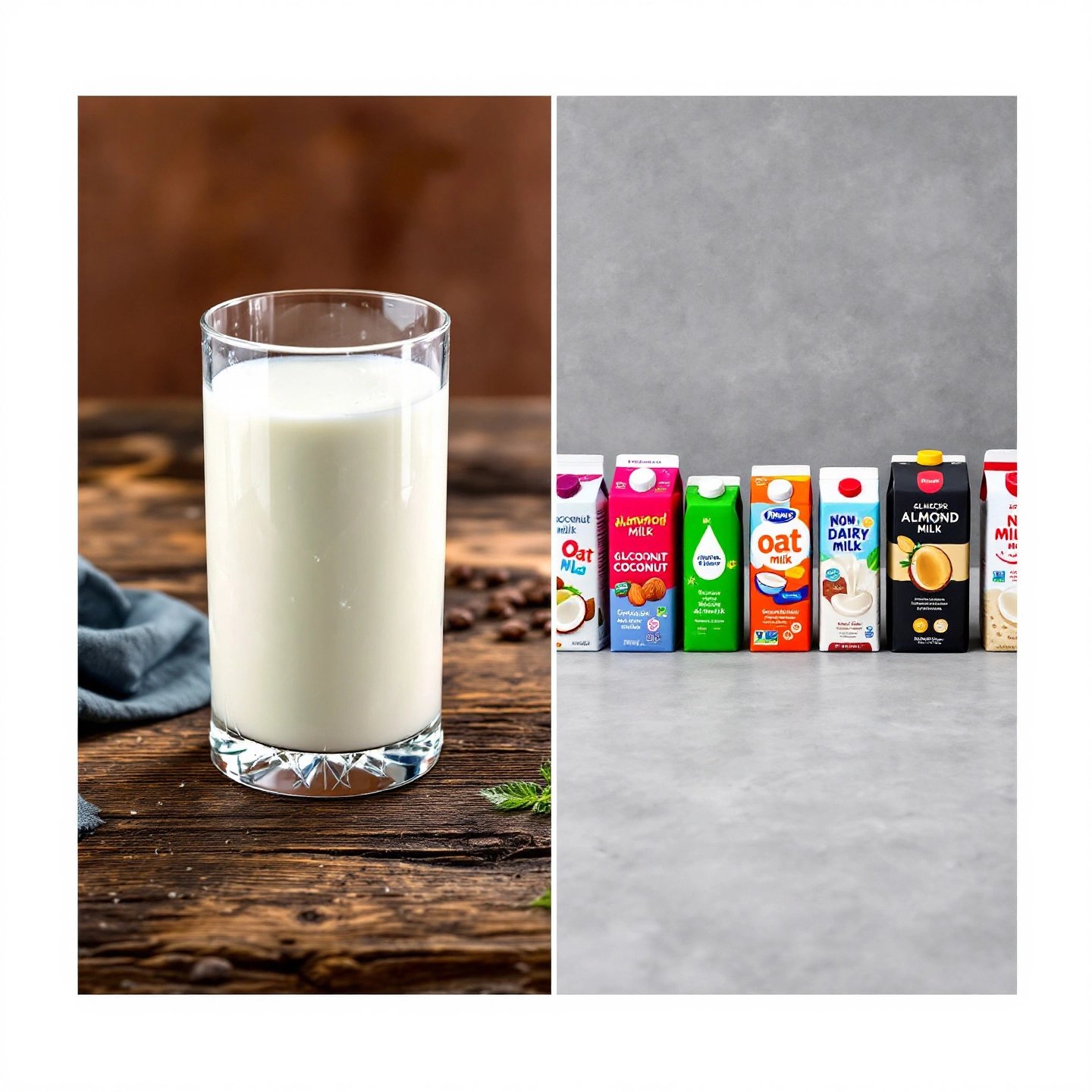Introduction: The Growing Popularity of Milk Alternatives
In recent years, the debate between dairy milk and non-dairy milk has gained significant traction, driven by the surge in popularity of plant-based alternatives. This trend is not just a fleeting fad; rather, it reflects a broader shift in consumer preferences influenced by health, environmental, and ethical considerations. The market for plant-based milk is expanding rapidly, with options such as almond, soy, oat, and even potato milk gaining shelf space in grocery stores worldwide. According to a report by the New York Times, sales of plant milk in the United States have reached $2.5 billion, underscoring the growing demand for these alternatives.
Several factors contribute to this shift. Health concerns, such as lactose intolerance and allergies, drive many consumers to seek dairy-free options. Moreover, the environmental impact of dairy farming, including high water usage and greenhouse gas emissions, prompts eco-conscious individuals to opt for more sustainable plant-based choices. Ethical considerations regarding animal welfare also play a significant role, as highlighted by experts from UNSW Sydney, who note the increasing awareness of livestock treatment in dairy production.
This article aims to provide a comprehensive comparison of dairy and non-dairy milk options, helping readers make informed choices. By exploring nutritional profiles, health benefits, environmental impacts, and taste preferences, we will guide you in selecting the milk that best aligns with your lifestyle and values. Whether you’re driven by dietary needs, environmental concerns, or simply curious about the taste, this guide will offer valuable insights into the ever-evolving world of milk alternatives.

Nutritional breakdown of dairy and non-dairy milk options (AI-generated)
Nutritional Comparison: Dairy Milk vs Non-Dairy Milk
When considering the nutritional profiles of dairy milk and non-dairy alternatives, it’s essential to examine key nutrients such as protein, calcium, vitamins, and minerals. Dairy milk, particularly whole milk, is renowned for its rich nutrient content, offering approximately 8 grams of protein, 12 grams of carbohydrates, and 150 calories per cup. It also provides a significant source of calcium, vitamin D, and vitamin A, often fortified to enhance its nutritional value. This makes cow’s milk a comprehensive choice for those looking to meet their daily nutrient requirements (Healthline).
Protein and Calcium Content
In contrast, plant-based milk alternatives like almond, soy, and rice milk vary in their nutritional offerings. Soy milk stands out among plant-based options, providing a protein content close to dairy milk, with about 7 grams per cup. It is often fortified with calcium and vitamins A and D, making it a viable alternative for those seeking similar nutritional benefits to cow’s milk (FDA). Almond milk, while lower in calories, typically contains only 1 gram of protein per cup but is frequently fortified to include calcium and vitamins.
Calorie and Fat Composition
Caloric content and fat composition are other critical factors when comparing these milk options. Whole dairy milk contains more calories and saturated fat compared to most plant-based milks, which tend to be lower in both. For instance, unsweetened almond milk contains about 30 to 60 calories per cup, significantly less than cow’s milk, making it appealing for those managing calorie intake. However, it’s important to note that some plant-based milks may contain added sugars and thickeners, which can alter their nutritional profile.
Impact on Health and Dietary Goals
These nutritional differences can significantly impact health and dietary goals. For individuals aiming to increase protein intake, dairy milk or fortified soy milk might be preferable. Conversely, those looking to reduce calorie consumption or avoid saturated fats may opt for almond or coconut milk. Understanding these distinctions helps tailor milk choices to individual dietary needs and health objectives.
While plant-based milks offer a variety of nutritional benefits, they do not naturally contain as many nutrients as cow’s milk. Thus, consumers should carefully read labels to ensure they are meeting their dietary requirements. As we delve deeper into the health implications of these milk choices, consider how these nutritional profiles align with your personal health goals.
Health Benefits and Concerns: Is Plant-Based Milk Good for You?
The choice between dairy and non-dairy milk often hinges on individual health needs and dietary restrictions. For many, plant-based milk offers a viable alternative, particularly for those with lactose intolerance or dairy allergies. Lactose intolerance affects a significant portion of the global population, making non-dairy options like almond, soy, and oat milk attractive choices. These alternatives are naturally lactose-free and can help individuals avoid digestive discomfort associated with lactose consumption (WebMD).
Benefits for Lactose Intolerance and Allergies
Plant-based milks provide a safe haven for those allergic to cow’s milk proteins. Unlike dairy milk, which can trigger allergic reactions ranging from mild to severe, non-dairy milks do not contain these proteins, offering a safer alternative for allergy sufferers. Additionally, plant-based milks are often fortified with essential nutrients, making them a nutritious substitute. For example, soy milk is typically fortified with calcium and vitamin D, closely mirroring the nutrient profile of cow’s milk (Healthline).
Concerns with Dairy Milk
While dairy milk is rich in essential nutrients such as calcium and vitamin B12, it also raises concerns due to the presence of hormones and antibiotics used in conventional dairy farming. These additives can affect hormone levels in consumers, leading some to seek plant-based alternatives. Moreover, dairy milk contains saturated fats, which some studies suggest may contribute to heart disease if consumed in excess (Healthline).
Potential Drawbacks of Non-Dairy Milk
Despite their benefits, non-dairy milks are not without drawbacks. Many commercial plant-based milks contain added sugars and stabilizers to enhance flavor and texture. These additives can increase calorie content and affect health if consumed in large quantities. Therefore, it’s crucial to read labels carefully and choose products with minimal added ingredients to maintain a healthy diet.
Ultimately, the decision between dairy and non-dairy milk should consider individual health conditions and dietary goals. Whether managing lactose intolerance, reducing saturated fat intake, or avoiding allergens, both dairy and plant-based milks offer unique benefits and potential concerns. As we explore the environmental impacts next, consider how these health factors influence your choice of milk.

Environmental impact comparison of milk production (AI-generated)
Environmental Impact: Dairy Production vs Plant-Based Alternatives
In the ongoing debate of dairy milk vs non-dairy milk, the environmental impact is a critical factor for many consumers. Dairy production is known for its significant environmental footprint, primarily due to the greenhouse gases emitted, extensive water usage, and land requirements. According to the World Wildlife Fund, dairy cows contribute notably to climate change through methane emissions, land degradation, and water pollution. The production of feed crops like corn and soy for dairy cattle further exacerbates these impacts, leading to habitat loss and soil depletion.
Water and Land Usage
Comparatively, plant-based milks generally require less water and land. For instance, producing a liter of cow’s milk requires significantly more water than producing the same amount of soy or oat milk. Ethical Consumer notes that soy milk uses about 90% less water and land than cow’s milk. Oat milk also presents a sustainable choice, requiring 85% less land and freshwater. These statistics highlight the potential for plant-based milks to reduce environmental strain.
Greenhouse Gas Emissions
Greenhouse gas emissions present another stark contrast. The dairy industry is a significant emitter of methane, a potent greenhouse gas. In contrast, plant-based milks like soy and oat have a carbon footprint approximately 50% lower than that of dairy milk. While almond and rice milks also offer lower carbon emissions, they have other environmental considerations, such as high water usage in almond production and methane emissions from rice cultivation.
Sustainability Considerations
When it comes to sustainability, choosing plant-based milk over dairy can significantly reduce one’s carbon footprint. However, it’s essential to consider the entire lifecycle of these products, including transportation and packaging, which can vary regionally. Additionally, the nutritional content of plant-based milks, often fortified with vitamins and minerals, plays a role in their overall sustainability profile.
Ultimately, while plant-based milks generally offer a more sustainable option compared to dairy, individual choices should also factor in nutritional needs and local environmental conditions. As we move into discussing the taste and versatility of these milk options, keep in mind how environmental factors influence your choice.
Taste and Versatility: Comparing Dairy and Non-Dairy Options
When it comes to taste and versatility, the debate between dairy milk and non-dairy milk becomes particularly interesting. Dairy milk, with its creamy texture and slightly sweet flavor, has long been a staple in households, lending itself well to a wide range of culinary applications. Whether used in coffee, cereal, or baking, its consistent taste and texture make it a reliable choice for many.
However, the rise of plant-based milks has introduced a diverse array of flavors and consistencies, each offering unique culinary possibilities. For instance, oat milk has gained popularity due to its creamy texture and subtle sweetness, making it an excellent choice for coffee and lattes. Its ability to froth similarly to dairy milk has made it a favorite among baristas. Almond milk, with its nutty undertones, is versatile in both sweet and savory dishes, enhancing smoothies, baked goods, and sauces without overpowering other flavors (Food & Wine).
Cooking and Baking Applications
In cooking and baking, soy milk stands out due to its higher protein content, which provides structure similar to that of cow’s milk. It works particularly well in baking, where its protein helps create tender cakes and muffins. For those seeking a richer alternative, coconut milk, especially the canned variety, offers a high-fat content ideal for creamy desserts and curries (The Chopping Block). Meanwhile, rice milk, with its light and neutral flavor, is perfect for delicate dishes like rice pudding or as a base for glazes.
Texture and Consistency
The texture and consistency of non-dairy milks vary widely, affecting their suitability for different uses. Cashew milk, for example, is known for its creamy consistency, making it a great substitute for cream in soups and sauces. Conversely, hazelnut milk, with its unique flavor profile, can be polarizing but works well in coffee or as a cereal companion.
Ultimately, the choice between dairy and non-dairy milk often comes down to personal taste preferences and the specific culinary application. Each type of milk offers distinct advantages and can transform a dish in unexpected ways. As you explore these options, consider trying homemade plant-based milk to customize flavors and textures to your liking, enhancing your culinary adventures.
Making the Right Choice: Factors to Consider
Choosing between dairy and non-dairy milk involves a thoughtful evaluation of several factors, ensuring that the chosen option aligns with personal health goals, dietary restrictions, environmental concerns, and taste preferences. As the variety of milk options continues to expand, understanding these factors can help consumers make informed decisions tailored to their needs.
Personal Health Goals
Health objectives play a crucial role in selecting the right milk. For those prioritizing protein intake, cow’s milk or fortified soy milk, which offers a protein content similar to dairy, might be preferable. Conversely, individuals looking to reduce calorie consumption or manage saturated fat intake may opt for almond or coconut milk, known for their lower calorie and fat profiles. It’s essential to consider any specific health conditions, such as lactose intolerance or allergies, which may necessitate choosing lactose-free or allergen-free options like rice or oat milk (Cleveland Clinic).
Dietary Restrictions and Preferences
Dietary needs significantly influence milk selection. Vegans and those avoiding animal products will naturally gravitate toward plant-based milks. Similarly, individuals with nut allergies should steer clear of nut-based milks like almond and cashew, opting instead for alternatives such as soy or hemp milk. It’s also important to consider carbohydrate content, as those managing blood sugar levels might prefer low-carb options like almond milk over higher-carb choices like oat milk (Culina Health).
Environmental Concerns
For eco-conscious consumers, the environmental impact of milk production is a significant consideration. Plant-based milks generally offer a more sustainable option, with lower greenhouse gas emissions and reduced water and land usage compared to dairy milk. However, the environmental footprint can vary among plant-based options, with almond milk requiring substantial water resources for production. Evaluating the sustainability of each option can guide environmentally responsible choices.
Taste Preferences
Taste and versatility in culinary applications are also vital considerations. Some may prefer the creamy texture of oat milk for coffee and lattes, while others might enjoy the nutty flavor of almond milk in smoothies and baking. Experimenting with different types of milk in various recipes can help discover which options best satisfy personal taste preferences and cooking needs.
As you navigate the diverse world of milk options, remember to carefully read labels and understand ingredient lists. This practice ensures that your choice aligns with your dietary and health goals, providing the nutritional benefits you seek. As we explore the rise of homemade plant-based milk next, consider how creating your own milk at home might offer further customization and control over ingredients.

Making plant-based milk at home offers customization and simplicity (AI-generated)
The Rise of Homemade Plant-Based Milk
As the popularity of plant-based milk continues to rise, more people are exploring the benefits of making homemade plant-based milk. This trend is driven by the desire for cost-effective, customizable, and additive-free alternatives to store-bought options. Homemade non-dairy milk allows individuals to tailor their milk to specific taste preferences and dietary needs, offering a level of personalization that commercial products often lack.
Benefits of Homemade Plant-Based Milk
One of the primary benefits of homemade plant-based milk is its cost-effectiveness. By purchasing raw ingredients like almonds, oats, or soybeans in bulk, consumers can significantly reduce the per-serving cost compared to pre-packaged options. Additionally, making milk at home eliminates the need for additives and preservatives commonly found in store-bought varieties, ensuring a purer product. This reduction in additives is particularly appealing to those with dietary restrictions or sensitivities.
Customization is another significant advantage. Whether you prefer a thicker consistency, a specific flavor profile, or a fortified version with added nutrients, homemade milk can be adjusted to meet these preferences. This level of control over ingredients not only enhances the nutritional value but also allows for experimentation with various flavorings such as vanilla, cocoa, or natural sweeteners.
Making Non-Dairy Milk at Home: Process and Equipment
The process of making homemade plant-based milk is straightforward and requires minimal equipment. A high-speed blender and a nut milk bag or cheesecloth are essential for blending and straining the milk. The basic steps involve soaking the chosen nuts, seeds, or grains, blending them with water, and straining the mixture to separate the liquid from the pulp. The remaining pulp can be repurposed in baking or cooking, minimizing waste.
For those interested in simplifying the process further, investing in a plant milk maker can be a worthwhile consideration. These appliances streamline the production of homemade milk, offering convenience and consistency. To explore top plant milk makers of 2025, visit our guide for a comprehensive overview of the best options available.
Addressing Concerns with Commercial Non-Dairy Milk
Homemade plant-based milk addresses several concerns associated with commercial products. Many store-bought non-dairy milks are packaged in Tetra Paks, which pose recycling challenges due to their composite materials. By making milk at home, consumers can reduce their environmental footprint and avoid the complexities of recycling these containers. Additionally, homemade options eliminate the need for stabilizers and emulsifiers, resulting in a more natural product.
In conclusion, making plant-based milk at home offers numerous benefits, from cost savings and customization to environmental considerations. As the demand for non-dairy milk grows, homemade alternatives provide a sustainable and personalized approach to enjoying these beverages. Whether you’re motivated by health, taste, or environmental impact, exploring homemade options can enhance your milk-drinking experience and align with your values.
Conclusion: Embracing Diversity in Milk Choices
As we wrap up the comprehensive examination of dairy milk vs non-dairy milk, it’s clear that there is no universal solution when it comes to selecting the best milk alternative. Each option presents its own set of benefits and potential drawbacks, making the choice highly personal and dependent on individual needs and preferences. Whether you’re considering nutritional content, health goals, environmental impact, or taste preferences, the key is to make informed decisions that align with your lifestyle and values.
For those navigating dietary restrictions or health concerns, experimenting with various milk options can be enlightening. Dairy milk offers a rich source of protein and essential vitamins, making it a staple for many. However, plant-based alternatives like soy, almond, and oat milk provide valuable options for those with lactose intolerance or allergies, as well as those seeking to minimize their environmental footprint (Washington Post).
It’s crucial to read labels carefully, as the nutritional content of plant-based milks can vary widely, particularly in terms of fortification with vitamins and minerals. This attention to detail ensures that your choice supports your health objectives, whether you aim to boost protein intake or reduce calories and saturated fats.
As you explore the best milk alternatives, consider the benefits of making plant-based milk at home. This practice not only allows for customization and cost savings but also reduces reliance on additives found in commercial products. For those interested in simplifying the process, using a plant milk maker can offer convenience and consistency. To discover top plant milk makers of 2025, explore our guide and find the perfect fit for your homemade milk endeavors.
Ultimately, embracing the diversity of milk choices empowers you to enjoy a beverage that complements your health, environmental, and culinary goals. By staying informed and open to experimentation, you can find the milk option that best suits your needs, enhancing both your diet and lifestyle.
Frequently Asked Questions
1. Is non-dairy milk healthier than dairy milk?
Non-dairy milk often has less fat and calories compared to whole dairy milk, making it a healthier choice for some, especially those managing weight or lactose intolerance. However, it’s essential to check for added sugars and fortifications to ensure nutritional adequacy.
2. What is the healthiest milk to drink?
The healthiest milk depends on individual dietary needs. While low-fat cow’s milk is nutrient-rich, soy milk offers similar protein levels and is lactose-free, making it a great alternative for those avoiding dairy.
3. What is the difference between dairy milk and non-dairy milk?
Dairy milk is derived from cows and is rich in protein and calcium, while non-dairy milk is plant-based, offering varied nutritional profiles. Non-dairy options are often chosen for lactose intolerance, allergies, or environmental reasons.
4. How does plant-based milk impact the environment?
Plant-based milks generally have a lower environmental impact than dairy, using less water and land. However, the sustainability varies among types, with almond milk requiring more water than other plant-based options.
5. Can I make plant-based milk at home?
Yes, making plant-based milk at home is simple, cost-effective, and customizable. Using a blender and strainer, you can create fresh almond, oat, or soy milk to suit your taste and dietary needs.
